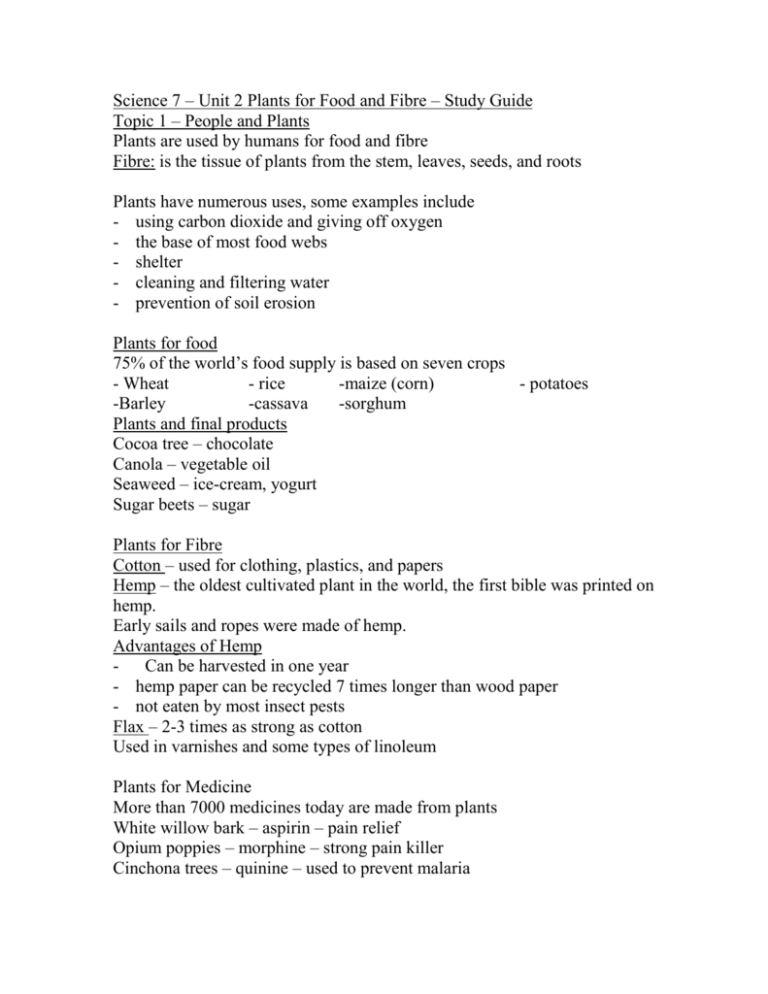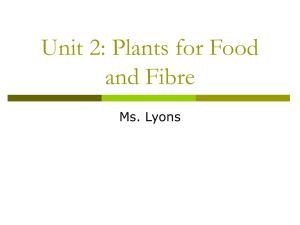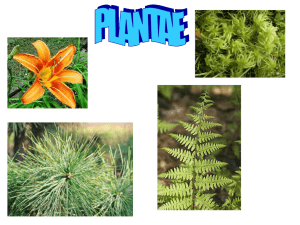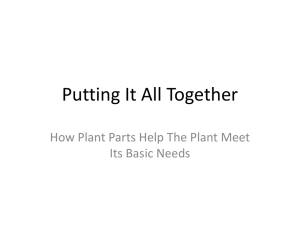Science 7 – Unit 2 Plants for Food and Fibre – Study Guide
advertisement

Science 7 – Unit 2 Plants for Food and Fibre – Study Guide Topic 1 – People and Plants Plants are used by humans for food and fibre Fibre: is the tissue of plants from the stem, leaves, seeds, and roots Plants have numerous uses, some examples include - using carbon dioxide and giving off oxygen - the base of most food webs - shelter - cleaning and filtering water - prevention of soil erosion Plants for food 75% of the world’s food supply is based on seven crops - Wheat - rice -maize (corn) - potatoes -Barley -cassava -sorghum Plants and final products Cocoa tree – chocolate Canola – vegetable oil Seaweed – ice-cream, yogurt Sugar beets – sugar Plants for Fibre Cotton – used for clothing, plastics, and papers Hemp – the oldest cultivated plant in the world, the first bible was printed on hemp. Early sails and ropes were made of hemp. Advantages of Hemp - Can be harvested in one year - hemp paper can be recycled 7 times longer than wood paper - not eaten by most insect pests Flax – 2-3 times as strong as cotton Used in varnishes and some types of linoleum Plants for Medicine More than 7000 medicines today are made from plants White willow bark – aspirin – pain relief Opium poppies – morphine – strong pain killer Cinchona trees – quinine – used to prevent malaria Plants for transportation and Construction Rubber Trees – brought about tires, which has enabled cars, planes and spacecraft Wood is used in construction around the world Plants are also used for fuel – ethanol-blended gasoline, coal for furnaces and electricity. Topic 2 – Structure and Adaptations Plant roots – often the plant is the tip of the iceberg Roots perform several important functions - they absorb water and minerals - they support and anchor the plant - they store food for the plant Taproot: main root, which can reach deep into the ground with numerous small roots, coming out of it. Root hairs: increase the surface area in which the plant can absorb water and nutrients. Fibrous Roots: shallow system of similar sized roots that quickly soak up moisture. Carrots, beets, turnips, radishes and parsnips are all edible roots Diffusion and Osmosis Two key functions that allow roots to absorb water and dissolved substances Diffusion: a tendency of particles to move from an area of high concentration to an area of low concentration. E.g.: air particles of perfume spread throughout the room. Differentially Permeable Membrane: allows some materials to pass through, yet keep other materials out. E.g. Marbles and sand in a mesh bag. Osmosis: a type of diffusion in which water moves form a high concentration to a low concentration. Functions of the Stem - transport water and nutrients between the leaves and the roots - provide support for the plant - food storage Leaves – the energy producers of the plants Leaves contain chlorophyll the pigment that makes them green. Photosynthesis takes place in the leaves. CO2 + H2O + Sunlight + nutrients ----- sugar + O2 Gases like carbon dioxide and oxygen enter and leave the plant through little openings in the leaves called stomata. Guard cells around the stoma (singular of stomata) regulate how much comes and goes. Respiration: process by which plants release CO2 and take in O2, this takes place at night and is slower than photosynthesis (good thing) Transpiration: the loss of water from a plant through evaporation, acts as a pump using osmosis to move water up the stem of the plant. Topic 3 – Plant reproduction and Breeding Selective Breeding: people choose specific plants with specific characteristics and encourage these plants to reproduce. Canola- made by using selective breeding of rapeseed. Genes: the part of the cell that controls plants characteristics. Types of Reproduction Sexual: involves the specialized seeds and fruits of two plants Asexual/vegetative reproduction: occurs when a parent plant grows plants from its roots, stems, or leaves. E.g. Grafting, taking the branch of one tree and attaching it to another. Seed Plant Reproduction Cones: the part of the tree that has a series of woody scales. Female cones contain ovules (eggs); Pollen grains containing sperm develop on the smaller male cone. When these two meet the sperm swims down the pollen tube and fertilizes the egg Pollination: The process of pollen travelling to the female cone. Flowers A flowers main job is to attract insects that will spread the plant pollen to other plants. Parts of a Flower Stamen: male part of the flower Pistil: female part of the flower Petals: usually brightly coloured Sepals: green parts found underneath the flower The pistil has three main parts: Stigma: sticky tip of the pistil that catches pollen Style: the tube connecting the stigma and the ovary Ovary: a tiny chamber that holds the ovule (eggs). Each Stamen has two parts: Filament: the stalk Anther: tip, produces pollen Pollination 3 steps 1) Pollen grain lands on the stigma 2) A pollen tube grows down the style into the ovary and enters an ovule 3) A sperms travels down the tube to fertilize the egg. Seed to Fruit Once a plant is pollinated a seed is formed, inside the seed is a tiny living plant called an embryo which is surrounded by food to keep it alive. Fruit: a growing ovary of a plant, which swells and protects the seeds until they are ripe. How seeds are dispersed: - carried by animals and insects - carried by winds or water - Humans use machines to efficiently plant crops This can take place in many creative ways *see page 127 for more Germination: is the development of a seed into a new plant. Topic 4 – Meeting the Need for Food and Fibre Canada is one of the leading exporters Food and Fibre in the World. Sustainability: being able to grow food and fibre while keeping our natural systems healthy for long term. Crops in Alberta Wheat: ground up for flour Barley: Fed to livestock, Used for making Malt. Oats: mostly fed to livestock some for breakfast cereals Legumes: Such as Peas, Faba Beans and Lentils, all high in protein Canola: used to make margarine, salad dressing etc. Potatoes: french fries, potato chips Alfalfa: feeds livestock, strong root system Specialty Crops: ginseng, beans, safflower, and spices Farming Practices Irrigation: watering crops using a system of large pipes and sprinklers Monoculture: growing only one type of plant in the field for greater efficiency *Copy Chart pg. 141 Forestry is a major industry in Canada Diversity: variety of plants and animals in an ecosystem Common Alberta Trees Lodgepole Pine: largely used in construction White Spruce: used in plywood, pulp and paper Black Spruce: lumber and strong paper Aspen: good for furniture, pulp and paper White Birch: Furniture and Firewood Tamarack (Larch): has a fungus that resist decay, so it is used on fence posts and railway ties. *Check out pie charts and tree pictures on Pg. 145 Steps in Harvesting Trees -Planning the cut (based on careful review of the site) -Building a road into the area -Felling and delimbing trees -Dragging the logs to a central loading point -Hauling the logs to sawmill -Preparing the site for reforestation -Reforestation Global Problems Erosion: Soil that is blown away by wind and water Desertification: as a result of drought desert takes over agricultural land Topic 5 - Sustaining the Soil Developing Soils – five main factors affect how soil develops: 1) parent material 2) vegetation 3) landscape 4) climate 5) time Humus: a dark soil rich in nutrients holds water well Healthy soil needs decomposers to break down dead organisms so plants can use the nutrients. There are four key types, which work differently: 1) Bacteria – actively break down dead material 2) Fungi – make nutrients available to plants 3) Microscopic actinomycetes – special kind of bacteria that help to create humus 4) Earthworms –grind, digest and mix soil. Healthy Plants require six nutrients -Nitrogen phosphorous potassium Sulfur calcium magnesium Challenges and Solutions Salty Soil – caused by too little vegetation and two much water Solution: replant areas so the water can’t dissolve the salt and leave it behind Soil Erosion – caused by too much cultivating mixed with water and wind Solution – leaving a root system in place to hold the dirt, zero tillage, shelter belts, crop rotation Hydroponic Technology - Growing plants without dirt, high energy cost Topic 6 – Pests and Pest Control Pest: any organism that humans find annoying or harmful Dandelions – the most successful plant pest, here’s why 1) Powerful roots 2) Broad leaves 3) Super seeds 4) Adaptable 5) Chemical weapons Check Wanted Poster on Pg. 166 Introduced Species: species not common to an area (often with no natural enemies) Pests were controlled by herbicides, insecticides, fungicides, and a bunch of other “cides”. Problems are associated with all of these chemicals E.g. bioaccumulation, and poisoning “innocent” species On top of this, Some pests are becoming resistant to chemicals Organic Food: food grown without the use of pesticides or chemical fertilizers. The need for chemicals is reduced by: -Sowing good quality seeds -Removing weeds early -Cutting weeds along property edges -Cleaning equipment so that it doesn’t transfer weeds. -Using biological controls







